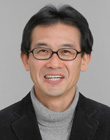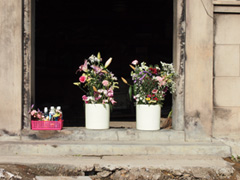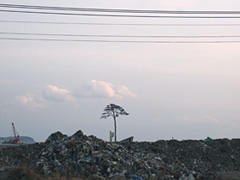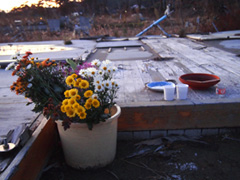Top>Opinion>Memories of the Great East Japan Earthquake
 Index
Index

Shigenori Iwata [profile]
Memories of the Great East Japan Earthquake
Shigenori Iwata
Professor, Faculty of Policy Studies, Chuo University
Areas of Specialization: Folklore, Historiography
1. Flower bouquets

Flower bouquets in a storehouse Otsuchi, Kamihei District, Iwate Prefecture
December 2011
I visited Otsuchi in Kamihei District, Iwate Prefecture at the end of 2011 (Heisei 23), the year of the Great East Japan Earthquake. It was my second visit there since the summer. I arrived in the early morning on the overnight bus. After listening to the story of the chief priest of a Buddhist temple where I had made an appointment, I walked around the former town, which was approaching its first winter after the disaster. Salmon were swimming up the river. A single storehouse that had escaped destruction stood beside the main road running through the brand-new landscape of the former town, where most of the rubble had been cleared away. Flower bouquets placed in large containers were in full bloom. It was the same sight that had greeted me when I came in the summer.
There was a solitary three-story reinforced concrete building that had escaped destruction. A café on the second floor had reopened—a café amid the ruins, one could say. I was the only guest at the time. I listened as the owner related tragic stories about the earthquake. As we gazed out the café window at the storehouse I mentioned earlier, the owner told me that a woman who had lost her daughter-in-law and grandchild came to the storehouse almost every day to leave flowers. It was where their bodies had been found.
2. One year after 3.11

The Lone Takata Pine amid the rubble Rikuzentakata, Iwate Prefecture
December 2011
On March 11, 2012 (Heisei 24), exactly one year after the earthquake, I made a visit to Rikuzentakata in Iwate Prefecture. I arrived in the early morning on the overnight bus. A light snow was falling that morning. It was my third visit. One year after the disaster, I passed through the brand-new landscape of the former city, where most of the rubble had been cleared away, and visited a Buddhist temple. I discreetly watched the morning Buddhist memorial service for the first anniversary of the victims’ deaths. I was impressed by the words of the chief priest, who said that from that day forward they would light candles, each marked with the name of one of the Rikuzentakata victims, and keep holding memorial services for them. In the afternoon, I watched the public memorial service. We observed a minute of silence at the moment when the earthquake hit. I saw many people who continued to face the sea with their eyes closed after the minute was over.
The Lone Takata Pine stands near the mouth of the Kesengawa River. I went through the mountains of wreckage and debris from the former Takata Matsubara Forest. I reached Takata Hospital at dusk. I decided to sit there even when it became completely dark. At that moment, right after the earthquake, many people had been waiting to be rescued inside the hospital and on the rooftop. I remembered seeing it on the news, and so one year later at the same time, I thought I’d try to share that moment with them in the darkness and bitter cold, though it was nothing like what they experienced. After that, I lost my sense of direction and couldn’t figure out where I was in the dark landscape of the former city that had been all but destroyed. I barely managed to make my way out of the old city area with my flashlight and the GPS feature on my smartphone.
3. Documentation of the Earthquake and after the Earthquake

Leaving a bouquet of flowers Higashimatsushima, Miyagi Prefecture
November 2011
Over two and a half years have passed since the Great East Japan Earthquake. To be honest, the last time I visited the disaster areas was last September, so I haven’t been back for a year. As I went around to several disaster areas on the pretext of one of my areas of specialization—the study of rituals for the dead and burial systems—I started worrying about whether I should write about it, and whether the study itself should be done. When I saw the cremated remains of unidentified people lined up at the Buddhist temples in Otsuchi and Rikuzentakata I mentioned earlier, and the special burials for disaster victims whose remains could not be cremated at several cities and towns in Miyagi Prefecture, I guess you could say I lost my ability to articulate what I was seeing and thought, this is what it is like to be at a loss for words. I also came to feel there was a deluge of one-sided, limited reports in the news I saw and heard in Tokyo—for example, in reports on the Lone Takata Pine, only footage of the solitary pine would be shown, while images of the surrounding wreckage, destroyed town and sunken earth were left out.
During the nuclear accident and the steps made toward “recovery” after the earthquake, many statements were made about the Great East Japan Earthquake in the media and various fields of research. One could even say it was a bit of a trend, especially during the first year. However, there are also many doubts as to whether these people actually set foot in the disaster areas and came into contact with the disaster victims.
Still, however, I think it is imperative that we remember the Great East Japan Earthquake, with the disaster areas, disaster victims, and above all, those who lost their lives as the protagonists of the story. There must be an overabundance of traumatic memories that seem as if they will never fade. There must be many people who are burdened with grief, whose grief is becoming more and more painful, who are losing their mental stability. So-called “disaster recovery” is extremely important, especially in communities that were basically destroyed by the earthquake, and is our top priority. At the same time, however, I have been wondering recently how we should preserve the inexhaustible reserve of memories of the Great East Japan Earthquake, including those we are making now, after the earthquake.
- Shigenori Iwata
Professor, Faculty of Policy Studies, Chuo University
Areas of Specialization: Folklore, Historiography - Professor Iwata is from Shizuoka Prefecture. He was born in 1961. He completed the coursework for the doctoral program in History (Japanese History) at the Graduate School of Letters, Arts and Sciences, Waseda University and withdrew before obtaining his doctorate in 1994. He holds a Ph.D. (in Sociology from the Graduate School of Human Relations, Keio University). After working as a full-time lecturer, assistant professor (associate professor), and professor at Tokyo Gakugei University, he assumed his current position in April 2013. His major publications include Youth of the Village, Youth of the Nation: Folk Traditions and National Unity [Mura no Wakamono, Kuni no Wakamono: Minzoku to Kokumin Tougou] (Miraisha); Where the Souls of the War Dead Go: War and Folk Traditions [Senshisha Reikon no Yukue: Sensou to Minzoku], The Folklore of Graves [Haka no Minzokugaku], and The Modern History of “Life”: From Abortion to Artificial Termination of Pregnancy [“Inochi” o Meguru Kindaishi: Datai kara Jinkou Ninshin Chuuzetu e] (All published by Yoshikawa Kobunkan); The Birth of the “Grave”: The Ethnography of Rituals for the Dead [“Ohaka” no Tanjou: Shisha Saishi no Minzokushi] (Iwanami Shinsho) and Tsuneichi Miyamoto: The Deviant Folklorist [Miyamoto Tsuneichi: Itsudatsu no Minzokugakusha] (Kawade Shobo Shinsha).
- Research Activities as a Member of Research Fellowship for Young Scientists (DC1), Japan Society for the Promotion of Science (JSPS) Shuma Tsurumi
- Important Factors for Innovation in Payment Services Nobuhiko Sugiura
- Beyond the Concepts of Fellow Citizens and Foreigners— To Achieve SDGs Goal 10 “Reduce Inequality Within and Among Countries” Rika Lee
- Diary of Struggles in Cambodia Fumie Fukuoka
- How Can We Measure Learning Ability?
—Analysis of a Competency Self-Assessment Questionnaire— Yu Saito / Yoko Neha - The Making of the Movie Kirakira Megane








